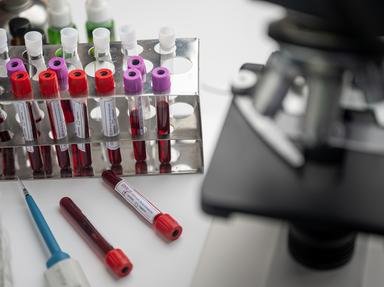Quiz Answer Key and Fun Facts
1. Plasma is the liquid part of the human blood that is like a soup, containing several mirco- and macromolecules suspended in a fluid. What is the most abundant protein in the human blood plasma?
2. Proteins are denatured when placed in a low pH (acidic) environment. Proteins lose their function when they are denatured. Enzymes are examples of a protein. In the stomach, pepsin is an enzyme secreted within the hollow space of the stomach which functions for digestion. However, the enzyme pepsin is not denatured in the stomach despite the very acidic environment attributed to hydrochloric acid (HCl). How can this be?
3. A bruise, medically known as a contusion, is made when a certain external area of the body is hit by something really hard, and the capillaries in that area collapse. It first appears on the skin with a violet color. After a few days, it becomes greenish in color. A few more days after, it appears yellowish in color, until it eventually fades and disappears. What causes the bruise to appear greenish in color?
4. Which of the following is NOT a form of a feedback inhibition?
5. Ammonia is a nitrogenous waste product of protein metabolism, and is harmful especially in high concentrations in the human body. Urea cycle is a means to detoxify and to prevent the accumulation of ammonia in the body by converting it to urea, and eventually excreted in the urine. How many moles of nitrogen enter the urea cycle in every turn?
6. Insulin is a peptide hormone produced in the pancreas by the beta cells. It aims to lower the glucose (sugar) levels in the blood, and is normally secreted every after meals. Their action is to activate the transporters of glucose found on the surface of cells, so that the cells can take up glucose from the blood and into the cells. What glucose transporter is regulated by the action of insulin?
7. It has been known that Vitamin A improves eyesight. However, this statement is not 100% true. What makes this claim about Vitamin A partly false?
8. Fiber-rich foods have been an essential part of everyday meals. Research have shown that regular consumption of fiber or fiber-rich food can lower the risk of having colon cancer. Question: What is this fiber made of?
9. Cancer has become one of the leading causes of death all over the world. The sudden increase in the number of cases in each countries alarmed the medical community and it has now become a focus in medical research and study. Question: What is the field in medicine that deals with the biology, diagnosis, and treatment of cancer?
10. Secondary messengers are needed by cells ligands only bind to surface receptors but its action would affect some internal structures within the cells. The following ligands require secondary messengers EXCEPT:
Source: Author
AlvarezMD
This quiz was reviewed by FunTrivia editor
crisw before going online.
Any errors found in FunTrivia content are routinely corrected through our feedback system.
